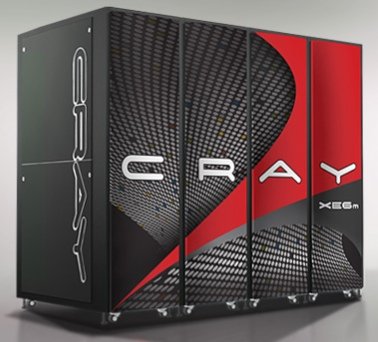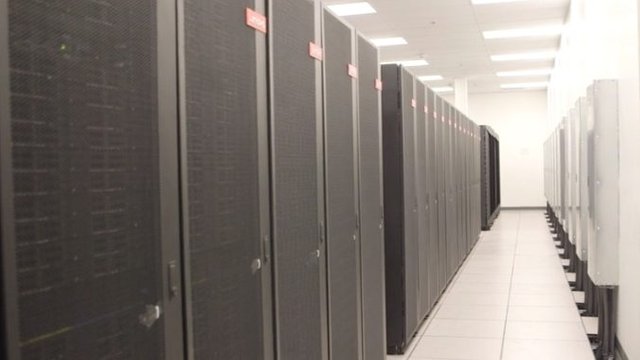ADSactly Tech News - What to Expect From the World of Supercomputers!
ADSactly Tech News: What to Expect From the World of Supercomputers!

- The “Trinity,” the Cray supercomputer at the Los Alamos National Laboratory’s Advanced Simulation and Computing (ASC) program is one of the most powerful computers ever designed.
- In an age of supercomputers scientists and physicists are tackling problems and solving problems never before possible.

As a technology writer I'm always looking for an exciting topic to research and share with my readers. Sometimes it can be quite difficult to find technology news worthy of being explored and explained in detail.
On a recent hunt for a new topic to write about as the @ADSactly technology writer, I came across a few articles about the current state of supercomputers being developed and used in the world at the present moment. In this article I'll discuss a few of the world's greatest supercomputers and what they are being used for.
First up is the Cray XC50 supercomputer developed in Japan. It was designed for a specific purpose. It was built to specifically conduct nuclear fusion research, which will begin production this year. Although the Cray XC50 supercomputer isn't the most powerful supercomputer on the planet, it is going to make history regardless considering the fact that it is the most powerful within the field of nuclear fusion research.
The National Institutes for Quantum and Radiological Science and Technology picked out the computer for its research, and the computer will be installed at the Rokkasho Fusion Institute, one of the institutes’ centers for nuclear research.
It will be used for local nuclear fusion science experiments, and it’ll also play a role in supporting ITER, a massive multinational fusion project headed by the EU that’s halfway to completion. Over a thousand researchers from Japan and other countries will be able to use the system, mainly for plasma physics and fusion energy calculations.
This is interesting that scientists are still pushing ahead with this new and undeveloped technology and now have access to supercomputers like the Cray XC50 to conduct their research. Humanity has the possibility of making monumental changes based on new technology and its use in research and development and this case is a good example of that idea in use.

/cdn.vox-cdn.com/assets/747622/cray-titan.jpg)

Another interesting thing to note about this new development is the fact that Japan has decided to decommission its previous, older system, called Helios. A little fun fact about Helios is that it had been ranked 15th most powerful supercomputer in 2012. What we are seeing is exponential advancements in this new and exciting field of supercomputer design.
Fusion energy is still a while away, as ITER’s first plasma reactor is slated to become operational in 2035 and will cost billions of dollars in investment. Still, advocates say that once it’s here, nuclear fusion could cover the world’s need for energy for over a thousand years at least and not bear the same climate change side effects as using fossil fuels or radioactive threat from nuclear fission.
Some readers may not be familiar when it comes to the difference between nuclear fission (the current method being used for power generation in the world) and humanity's goal of using nuclear fusion in the future. Basically it is the difference between splitting atoms (fission) to create energy vs merging atoms to create energy (fusion). It is believed that fusion could be exponentially more effective in creating and capturing energy.
In regard to the topic of supercomputers I'd like to make the point that although it does seem like Japan may be a few laps ahead in the race to dominate the role of top supercomputer producer of planet Earth, the US isn't sitting on their hands here! They have also made incredibly large investments in the supercomputer arms race. In fact they pumped in $258 million last year alone in funding for companies that include but are not limited to Cray, AMD, Intel, Nvidia, and others. The US fully intends to be a major power and assert its dominance in the ownership and use of large exascale computers that can perform a billion billion calculations per second.


So far I've established that Cray is a major player in this new and exciting field of supercomputers. I've also demonstrated the fact that both Japan and the USA are heavily involved in a sort of supercomputing arms race. But one thing I haven't mentioned yet is some of the stiff competition that Cray may face moving forward.
SciNet and the University of Toronto recently unveiled the “Niagara,” Canada’s most-powerful supercomputer. As you can see above it is a massive system that utilizes a 1,500 dense Lenovo ThinkSystem SD530 high-performance compute nodes.
Now I'm going to get even more techy in saying that the Niagara is a beast that delivers 3 petaflops of Linpack performance. Basically its a processing powerhouse capable of performing calculations beyond the wildest imagination of PC users trying to render their latest youtube video.
According to a recent article published by HPC Wire, the Niagara serves researchers across Canada. It assists researchers in fields that include artificial intelligence, astrophysics, high-energy physics, climate change, oceanic research and other disciplines that require the use of big data.
“There isn’t a single field of research that can happen without high-performance computing,” said SciNet’s CTO Daniel Gruner in a video presentation. “All Canadians will benefit from Niagara because basic research, fundamental research, is so important to the development of what we now call applied research. Without the basic research nothing can happen.”
Niagara is one of four new systems being deployed to Compute Canada host sites. The others are Arbutus, a Lenovo-built OpenStack cloud system being deployed at the University of Victoria; Cedar, a 3.7-petaflop (peak) Dell system installed at Simon Fraser University, and Graham, a 2.6-petaflop (peak) Huawei-made cluster, located at the University of Waterloo.
As far as I understand, both Cray and Compute Canada are in direct competition creating supercomputers that blow the standard PC out of the water! Competition is good as it encourages speedier development and reduces overall costs of deployment in fields involving technology.
There's a large demand for supercomputers primarily coming from governments and giant multi-national corporations so there's plenty of investment to go around in this field as well.


With a peak theoretical speed of 4.61 petaflops and a Linpack Rmax of 3 petaflops, Niagara ranks among the top 10 percent of fastest publicly benchmarked computers in the world today. System maker Lenovo has made both HPC and supercomputing a priority since it acquired IBM’s x86 business for $2.1 billion in 2014 and its ambitions aren’t stopping.
It’s deployed the fastest systems in Spain, Italy, Denmark, Norway, Australia, Canada, and soon in Germany with Leibniz Supercomputing Center, and it counts 87 Top500 systems (inclusive of all Top500 Lenovo classifications, i.e., Lenovo (81), Lenovo/IBM (3), IBM/Lenovo (2) and this collaboration). This puts it in second place by system share, behind HPE, and in third place after Cray and HPE based on aggregate list performance.
As you can see the stakes are huge and there are many big players including Lenovo, Cray and HPE. All of these corporations have huge budgets and the scale of their research and development departments is incredible. In the world of supercomputing its all about the petaflops!
What do you think about this supercomputing arms race? Do nations need to come together in terms of pooling their resources in an effort to improve co-operation? Do you think this new craze to create the most powerful supercomputer in the world will end well for humanity? What sort of use cases can you see being assisted through the use of these amazing supercomputers?
Here's a chance for the @ADSactly community to leave their thoughts and opinions on this topic!
Thanks for reading.
Authored by: @techblogger
In-text citations sources:
'Japan is commissioning the world’s most powerful nuclear fusion research supercomputer' - The Verge
'SciNet Launches Niagara, Canada’s Fastest Supercomputer' - HPC Wire
Image Sources:
The Verge, HPC Wire, Pexels

Click on the coin to join our Discord Chat

Witness proposal is here:
Go To Steem Witness Page
In the bottom of the page type: adsactly-witness and press vote.

Use small letters and no "@" sign. Or, click here to vote directly!
Thank you!


It is weird because computers are basically replacing everything. Nowadays you don't need a TV because your computer can do exactly the same things or even better things than a computer, also you don't need a radio, or a video game console, and as computers keep becoming smaller we won't need cellphones because their functions will get mixed in just one device.
On the other side, all of our daily activities are already being replaced by a phone, and even our accessibility to the outer world is being superseded by pages where you can buy anything you want (even food).
I wonder where this will lead to...Not sure if it's beneficial or more dangerous, but of what I'm very sure, is that this is changing a lot the way the world works and we have to adapt to it... after all, civilizations has always been full of changes :)
Change is the only constant thing in life, hope the introduction of super computers will not make a lot of people jobless.
since super computers are only capable of single tasking, while mainframe are the one thats is multitasker, possibly super computer could leverage the development of A.I and deep learning algorithm.
Unfortunately I expect that governments will not join together to use this power for the advancement of humanity. Rather they will continue to use the most advanced technology they can purchase (using wealth taken from us) to further their own personal power and control over the masses. The increase in technology increases knowledge, in the hands of individuals it would be used for good. Knowledge in the hands of government is always used against the individuals opposing the governments drive for more control and power.
adsactly contest i so like
Mr. @adsactly
We Expect very comfortability from the World of Supercomputers. And awaiting of passing easy life through supercomputers.
Not sure if supercomputers will make our lives easier or harder. It is my guess that they will make our lives much different. Be ready for change :)
Verry nice post big thumbs up and a resteem from my side for hard work and dedication
Thanks for the thumbs! Are they just on loan or do we get to keep them?
well.....very nice analysis......history says, abusing of technology brings much harm for human and we are experiencing that. people get addicted to be more and more powerful and that can be the cause to the eand of mankind. wish all these technological advancement will bring out the best for human kind, not the destruction. cheers:-)
This reminds me of Alienware computers, those were the days. Not just fast but also nice to look at
Yah exactly! Its a monster size Alienware computer!!
Nice post thanks... follow you blog great thank you.
You're welcome. I'm sure @ADSactly appreciates your support!
Isn't it the chinese holds the fastest super computer in the whole world?
I thought it was the Japanese but you may very well be right! There are certainly tons of secret programs normal plebs have no knowledge of whatsoever!